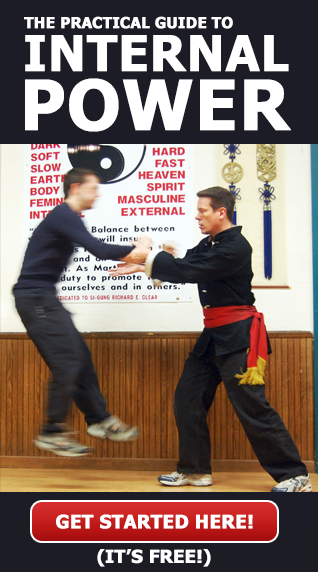Rooting in Tai Chi is using mind intent to send your energy down into the ground.
You might have learned rooting as a metaphysical skill where the rooting is just about being psychologically connected and centered but doesn’t have much impact in the physical world.
This is not that kind of rooting.
A deep, strong root can be tangibly felt.
Imagine a 30 foot pole with 2 feet stuck in the ground.
It wouldn’t be that difficult to push over, would it?
It might even fall over all on it’s own.
Now image the same 30 foot pole with 25 feet stuck in the ground.
This pole would be a lot more of a challenge to knock down.
This is what a solid root feels like.
A person who has solid Tai Chi structure and a strong and deep root will feel this way to someone who tries to push them over.
A skilled Tai Chi student can sense how deep and how thick an opponents’ root is.
To someone who isn’t trained in Tai Chi sensitivity, pushing over a well-rooted person will just feel like trying to push over a solid wall.
I Have a Friend Who Says He Can Root, But He Doesn’t Feel Very Solid.
You or someone you know might be aware of the concept of root and be able to do it a little bit, but you might not have gotten very deep.
Many people have roots that are between one inch and one foot into the ground.
This is a good place to start.
Some root is better than none at all.
But if you think about the example of the iron pole example, this kind of root is not going to help much with martial applications.
Most of the person’s combined body and root are above the ground.
To really begin to see some root applications a person must have a root of at least their own body height.
And you should work to get to about 20 feet or 3 times your height as quickly as possible.
You or your rooting friend also might be among those who have gotten that 6-to-20 foot root whose root is very thin.
To be effective, your root must be at least as wide as the widest part of your body.
If you have a size 40 waist, then this is your first goal.
Eventually you want to be able to expand your root to the size of a room or courtyard.
This might seem like a herculean task at first-
But I have trained many students at this point to do just that.
If you want to build that skill- it does require work.
No amount of absent minded set work is going to get you there.
But if you want a clear path forward that will show you the roadblocks- and how to remove them, you will find that in The Practical Guide to Internal Power.
You can start this course for FREE here:

Why Dropping Root Comes First
Dropping root is really a method of emitting energy.
Tai Chi teaches many different ways of emitting and using energy, but root is easiest to learn because it involves sending energy downward.
With rooting, gravity is completely on your side.
Because of this, dropping root is the easiest form or energy emission to learn.
The skills you learn while dropping root will be useful for emitting energy in other directions later on.
There are other uses for root beyond the iron-bar-in-the-ground martial application-
But before you can do that- you’re going to have to build a deep root, yourself.
How to Build Root and Correct Your Form with One Simple Exercise
This one skill Tai Chi excels at is the ability to direct force inside the human body.
At an advanced level this allows you to direct the force of a light shove our strike inside someone’s body to rupture an internal organ or take advantage of their tension or structural errors.
Master Yourself before you can Master others.
But before you can learn to direct force inside someone else you must first be able to manipulate force inside your own body.
So here’s a simple exercise to get you started.
Not only will this exercises teach you about directing lines of force through the body it will also build your root and you can use it with any Tai Chi posture to find and correct any structural errors you may have.
We call this exercise “Feeding the Root” and all you do is take any incoming force and direct it downward into the ground. Eventually you want to be able to send it anywhere. Up, Out, Back into an Opponent, etc.
Just remember, when I said simple I did not mean easy.
Feeding the Root (beginners version)
1. Begin by standing in Wu Chi.
2. Have your partner put a hand on your shoulder and slowly press downward.
3. As your partner presses downward, adjust your alignment until you feel the pressure from their push on the bottom of your foot going into the ground. Send the force to one leg or the other, whichever feels most natural.
You may have to play with this a bit at first. Have your partner start with a light amount of force and then slowly increase the pressure as you get your alignment right.
If there is an error in your posture, if you tense up, or if you let your structure collapse you will feel it at that spot or you will get pushed.
If your structure is correct then your partner will be able to push as hard as they can while you stand comfortably relaxed.
Partners who are practicing Tai Chi or have some sensitivity will be able to feel you routing the force down into the ground.
4. Now have your partner let up from the place where they were pressing. They should do this slowly as well. You want the energy of the press to flow down into the ground but not come back up. If your partner lets up slowly, it will allow you to do this.
5. Step 4 completes the exercise for one spot on your body. Repeat steps 1 through 4, but this time in many different places on your body. Work from the head to the feet. Press down into the head, the chest, the hips, the arms, the belly, the back and the legs.
Find the areas your partner struggles with and help them make corrections.
If you are routing the force downward the way you should, you should feel the force of the push on your feet. When you feel this, relax and melt your feet and let the force go down into the ground.
Feeding the Root (Intermediate versions)
Once you’ve gotten the basic exercise down, you will want to increase the level of difficulty.
1. Do the same exercise, only this time, instead of pressing straight down, have your partner press at a downward angle.
2. Have your partner press at a mostly horizontal angle, but still a little bit down.
3. Have your partner press horizontally.
4. Have your partner press at an upward angle. (You still direct the force down into the ground.)
5. Have your partner increase the speed at which they push you. Eventually you can train this against strikes. (Just make sure the person striking is careful to protect their wrists so they don’t hurt themselves.)
6. As your partner presses, every once in awhile, they should try quickly letting up on the push without warning you. When your partner does this, you should not jolt or be thrown off balance. This shows whether you are leaning against your partner or really routing the force into the ground.
7. Now do all this with each form in the set.
8. Now while moving through the form.
9. And of course practice this in push hands while your partner is trying to do the same thing you are.
Do you want to see how this is done on video?
Do you want to know where to go from here?
My video course, The Practical Guide to Internal Power will take you from ANY point in your journey-
Even if you’re brand new to the arts-
And show you exactly what you need to do to build the Internal Power skills you’ve been looking for.
No catch. No vague mysteries. And right now, you can get it for FREE.

Thank you for reading- and I hope this has helped you with your training.
-Sifu Clear.

I have a hip that I try to work around. I work for the root as you say. You have the best expl. I’ve read. I’ m 73 so internal is the way to go! Thanks
Hi DD,
Thanks for following us! Internal is indeed the way to go. Keep up the good training!
Hello Richard.Happy new year to you and your family and thanks for the information you have given me over the years.When I was in my middle 40 i praticed with Benjamin Low Peng.At that time I was a well trainde police oficer with 105 kg in benchpress and weight ca 90 kg.Ben was a chinese 170 high and not very powerful.He was standing just up and down with both feet side by side relaxed(like a man who want to buy a paper in the kiosk).I put all my weight on him, and all my force into his chest and tried to push him over.He smiled and said,Hans you are too strong you have to relass.I could not move him and have never understood what he did.